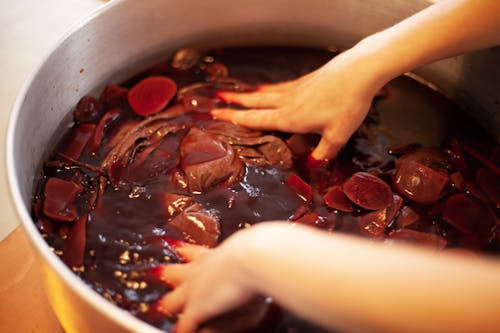
I try to align the binding and mordanting stages with cooking beetroot dishes – that way I can directly use the waste for my dye. But it’s also possible to freeze the cooking water and/or beetroot skins and scraps and use them at a later date. To obtain my beetroot dye, I cook the skin in the beetroot cooking water, topping up with tap water as needed. I bring to a boil and then let simmer for at least an hour, stirring occasionally, and letting it cool a little once it reaches a deep, opulent shade. Entertainingly, the dye vat of dye can resemble a pot of fresh blood, giving the impression you are engaging in some sort of witchcraft. Most manuals I have come across instruct you to strain the dye and discard the leftovers in the compost bin.
I prefer adding my beetroot water with bits included to the primary dye vat, as the beetroot pieces will continue to release pigment as I squeeze and stir them with the fabric, creating occasional streaks of stronger dye – an effect I quite like. Once I get a good coating on my fabric,I return the pot to the heat source and bring it to a gentle boil, simmering for two hours. I then leave it to soak overnight.
(Photo by Julius Honnor)